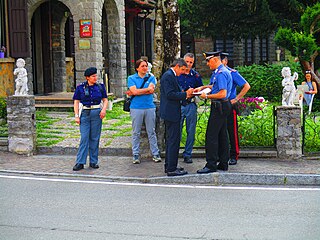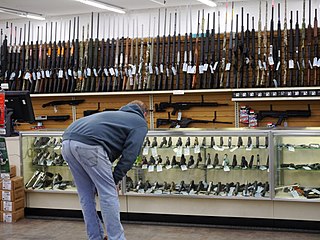Related Research Articles

Gun control, or firearms regulation, is the set of laws or policies that regulate the manufacture, sale, transfer, possession, modification, or use of firearms by civilians.

John Richard Lott Jr. is an American economist, political commentator, and gun rights advocate. Lott was formerly employed at various academic institutions and at the American Enterprise Institute conservative think tank. He is the former president of the Crime Prevention Research Center, a nonprofit he founded in 2013. He worked in the Office of Justice Programs within the U.S. Department of Justice under the Donald Trump administration from October 2020 to January 2021. Lott holds a Ph.D. in economics from UCLA.

More Guns, Less Crime is a book by John R. Lott Jr. that says violent crime rates go down when states pass "shall issue" concealed carry laws. He presents the results of his statistical analysis of crime data for every county in the United States during 29 years from 1977 to 2005. Each edition of the book was refereed by the University of Chicago Press. As of 2019, the book is no longer published by the University of Chicago Press. The book examines city, county and state level data from the entire United States and measures the impact of 13 different types of gun control laws on crime rates. The book expands on an earlier study published in 1997 by Lott and his co-author David Mustard in The Journal of Legal Studies and by Lott and his co-author John Whitley in The Journal of Law and Economics, October 2001.

Homicide is an act in which an agent causes the death of a separate human being. A homicide requires only a volitional act, or an omission, that causes the death of another, and thus a homicide may result from accidental, reckless, or negligent acts even if there is no intent to cause harm. It is separate from suicide.
Gary Kleck is a criminologist and the David J. Bordua Professor Emeritus of Criminology at Florida State University.
In the United States, habitual offender laws have been implemented since at least 1952, and are part of the United States Justice Department's Anti-Violence Strategy. These laws require a person who is convicted of an offense and who has one or two other previous serious convictions to serve a mandatory life sentence in prison, with or without parole depending on the jurisdiction. The purpose of the laws is to drastically increase the punishment of those who continue to commit offenses after being convicted of one or two serious crimes.
Concealed carry, or carrying a concealed weapon (CCW), is the practice of carrying a weapon in public in a concealed manner, either on one's person or in close proximity. CCW is often practiced as a means of self-defense. Following the Supreme Court's NYSRPA v. Bruen (2022) decision, all states in the United States were required to allow for concealed carry of a handgun either permitlessly or with a permit, although the difficulty in obtaining a permit varies per jurisdiction.
In the United States, the relationship between race and crime has been a topic of public controversy and scholarly debate for more than a century. Crime rates vary significantly between racial groups; however, academic research indicates that the over-representation of some racial minorities in the criminal justice system can in part be explained by socioeconomic factors, such as poverty, exposure to poor neighborhoods, poor access to public and early education, and exposure to harmful chemicals and pollution. Racial housing segregation has also been linked to racial disparities in crime rates, as black Americans have historically and to the present been prevented from moving into prosperous low-crime areas through actions of the government and private actors. Various explanations within criminology have been proposed for racial disparities in crime rates, including conflict theory, strain theory, general strain theory, social disorganization theory, macrostructural opportunity theory, social control theory, and subcultural theory.
Sex differences in crime are differences between men and women as the perpetrators or victims of crime. Such studies may belong to fields such as criminology, sociobiology, or feminist studies. Despite the difficulty of interpreting them, crime statistics may provide a way to investigate such a relationship from a gender differences perspective. An observable difference in crime rates between men and women might be due to social and cultural factors, crimes going unreported, or to biological factors. The nature or motive of the crime itself may also require consideration as a factor. Gendered profiling might affect the reported crime rates.

Crime in Australia is managed by various law enforcement bodies, the federal and state-based criminal justice systems and state-based correctional services.

Deterrence in relation to criminal offending is the idea or theory that the threat of punishment will deter people from committing crime and reduce the probability and/or level of offending in society. It is one of five objectives that punishment is thought to achieve; the other four objectives are denunciation, incapacitation, retribution and rehabilitation.

Gun violence is a term of political, economic and sociological interest referring to the tens of thousands of annual firearms-related deaths and injuries occurring in the United States. In 2022, up to 100 daily fatalities and hundreds of daily injuries were attributable to gun violence in the United States. In 2018, the most recent year for which data are available, the Centers for Disease Control and Prevention's (CDC) National Center for Health Statistics reported 38,390 deaths by firearm, of which 24,432 were suicides. The national rate of firearm deaths rose from 10.3 people for every 100,000 in 1999 to 11.9 people per 100,000 in 2018, equating to over 109 daily deaths. In 2010, there were 19,392 firearm-related suicides, and 11,078 firearm-related homicides in the U.S. In 2010, 358 murders were reported involving a rifle while 6,009 were reported involving a handgun; another 1,939 were reported with an unspecified type of firearm. In 2011, a total of 478,400 fatal and nonfatal violent crimes were committed with a firearm.

Gun-related violence is violence committed with the use of a firearm. Gun-related violence may or may not be considered criminal. Criminal violence includes homicide, assault with a deadly weapon, and suicide, or attempted suicide, depending on jurisdiction. Non-criminal violence includes accidental or unintentional injury and death. Also generally included in gun violence statistics are military or para-military activities.

Crime in Italy, though low compared to other developed countries, is present in various forms throughout the nation. Italy is notorious for its organized crime groups, which are present worldwide and collectively referred to as the Mafia. Resultantly, financial crimes like corruption, extortion, and theft are the most common type of illicit activity in the country. Violent crimes are exceedingly rare in Italy evidenced by its homicide rate of 0.51 per 100,000 inhabitants in 2021, the lowest in Europe aside from Luxembourg and Slovenia, and one of the lowest in the world.

In 2018, the Small Arms Survey reported that there are over one billion small arms distributed globally, of which 857 million are in civilian hands. The survey stated that American civilians account for an estimated 393 million of the worldwide total of civilian held firearms, or about 120.5 firearms for every 100 American residents.

Race in the United States criminal justice system refers to the unique experiences and disparities in the United States in regard to the policing and prosecuting of various races. There have been different outcomes for different racial groups in convicting and sentencing felons in the United States criminal justice system. Although prior arrests and criminal history is also a factor. Experts and analysts have debated the relative importance of different factors that have led to these disparities.

The Public Safety and Recreational Firearms Use Protection Act, popularly known as the Federal Assault Weapons Ban, was subtitle A of title XI of the Violent Crime Control and Law Enforcement Act of 1994, a United States federal law which included a prohibition on the manufacture for civilian use of certain semi-automatic firearms that were defined as assault weapons as well as certain ammunition magazines that were defined as large capacity.
Tomislav Victor Kovandzic is an American criminologist and professor at the University of Texas at Dallas.

The crime drop or crime decline is a pattern observed in many countries whereby rates of many types of crime declined by 50% or more beginning in the mid to late 1980s and early 1990s.
Grant Duwe is an American criminologist and research director at the Minnesota Department of Corrections, as well as a non-visiting scholar at Baylor University's Institute for Studies of Religion. Duwe holds a bachelor's degree from the University of Kansas and a Ph.D. in Criminology and Criminal Justice from Florida State University.
References
- ↑ "Carlisle E. Moody". Library of Congress. Retrieved 22 January 2016.
- ↑ "Carlisle E. Moody CV". College of William & Mary website. Retrieved 22 January 2016.
- 1 2 Robison, Mark (3 June 2015). "Fact Checker: Do more guns increase crime?". Reno Gazette-Journal. Retrieved 22 January 2016.
- ↑ Whitaker, Leslie (22 February 1998). "Crime In The Streets". Chicago Tribune. Retrieved 22 January 2016.
- ↑ MARVELL, THOMAS B.; MOODY, CARLISLE E. (May 1995). "The Impact of Enhanced Prison Terms for Felonies Committed with Guns". Criminology. 33 (2): 247–281. doi:10.1111/j.1745-9125.1995.tb01178.x.
- ↑ Goldstein, Dana (14 October 2015). "Politicians Still Say Longer Prison Sentences Prevent Gun Violence — But Do They?". The Marshall Project. Retrieved 22 January 2016.
- ↑ Marvell, Thomas B.; Moody, Carlisle E. (January 2001). "The Lethal Effects of Three-Strikes Laws". The Journal of Legal Studies. 30 (1): 89–106. doi:10.1086/468112. S2CID 153684944.
- ↑ Marano, Lee (16 September 2002). "Study: 3-strikes laws increase homicides". UPI. Retrieved 22 January 2016.
- ↑ Duwe, G.; Kovandzic, T.; Moody, C. E. (1 November 2002). "The Impact of Right-to-Carry Concealed Firearm Laws on Mass Public Shootings". Homicide Studies. 6 (4): 271–296. doi:10.1177/108876702237341. S2CID 145224076.
- ↑ Schroeck, Eric (14 January 2011). "Fox & Friends Hosts GOP Lawmaker To Push Myth That More Guns Deter Crime". Media Matters. Retrieved 23 January 2016.
- ↑ Kopel, David B.; Moody, Carlisle E.; Nemerov, Howard (2008). "Is There a Relationship between Guns and Freedom? Comparative Results from 59 Nations" (PDF). Texas Review of Law and Politics. doi:10.2139/ssrn.1090441. S2CID 142316080. Archived from the original (PDF) on 2019-12-31.
- ↑ Bandow, Doug (24 January 2013). "Guns and Freedom". American Spectator. Archived from the original on 29 January 2016. Retrieved 22 January 2016.
- ↑ Masters, Brooke (19 October 2000). "Allen Takes Credit for Crime Drop". The Washington Post. Retrieved 22 January 2016.